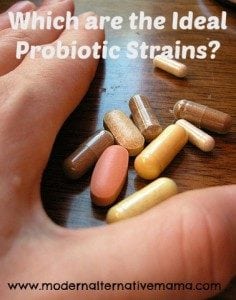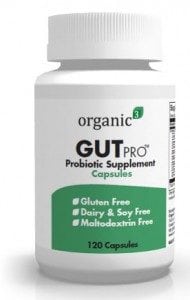Over the years on this blog, I have talked about probiotics a lot. Search for the word and you’ll find dozens of different posts that mention it.
That’s because probiotics are one of the most important parts of your health. Having good gut flora is a fairly new area of research, but healthy gut flora has already been shown to:
- Reduce incidence of diarrhea
- Reduce incidence of stomach viruses
- Reduce obesity
- Improve lactose intolerance
- Reduce or eliminate eczema
- Actually improve brain function in memory and emotional response (see this study)
- Synthesizes necessary vitamins (K, B12, B1, B9, etc. — see study)
- …and more!
Probiotics are pretty darn cool, and pretty darn necessary.
The thing is, most of us don’t have very good gut flora. Too many things in our environment impact our flora negatively. We don’t really have the research to say exactly what is impacting us most, or how bad any individual thing really is. But we know that a lot of aspects of our modern lifestyle are not very good for our gut flora. This includes:
- Antibiotic use (non-controversial; this absolutely kills good gut flora, which can lead to repeat infections)
- Candida overgrowth (worsened by excess sugar consumption)
- C-section births
- Other pharmaceutical drugs
- High-sugar foods
- GMOs (possibly)
Antibiotics are the single greatest threat to our gut flora, since they are actually designed to kill it. There is such a long, long list of negative effects of antibiotics that I, personally, would only choose them in a very, very serious situation. That’s beyond the scope of this post, though.
The real question today is, with all the probiotic supplements on the market today…is there one you should choose? And what strains are the best ones to have in a supplement?
Probiotic Supplements
I really love to focus on probiotic-rich foods, personally. That includes yogurt, kefir, kombucha, fermented pickles, etc. However, these foods are either expensive to buy or require some work to prepare, and I find that, especially in busy seasons, I simply don’t keep up with it. I have, at various points, had kombucha brewing (for several years now), sourdough starters, milk and water kefir, yogurt, and have attempted to ferment various types of fruits and veggies. Someday I’d like to be a pro at it and do it consistently and feed my family these probiotic foods multiple times a day.
For now I’m realistic, and I use a probiotic supplement. In today’s busy world, sometimes that is just the best solution.
There are so many choices on the market now that it’s hard to know what supplements are really quality. I saw some sitting on a shelf at Big Lots recently…I had to wonder, how effective could they be, really?
My goals with a probiotic supplement are simple:
- As few “extra” ingredients (besides the probiotics and growth culture) as possible
- Well-researched, beneficial strains
We’ll come back to that first point in a bit. For now, let’s take a look at probiotic strains.
What Are the Ideal Probiotic Strains?
We don’t actually know what “ideal” gut flora looks like.
Right now, we know that there appear to be three distinct “types” of gut flora. We don’t know, obviously, what truly biologically normal flora looks like since most everyone has had antibiotics and other negative factors at some point in their lives (probably several points) and we don’t know just how resilient flora really is. We may never be able to tell what “perfect” human gut flora is — if there is any such thing, anyway.
What we do know, though, is what strains are most commonly found in healthy, exclusively breastfed babies (exclusive breastfeeding is the biological norm, so we can assume the flora that develops in the majority of exclusively breastfed babies is the norm). We also know, from various studies, which strains seem to have the most positive effects on both the composition of the gut flora and in measurable impacts on life (reduction in weight, changes in brain function, etc.). We’re going to look at these two types of information when determining the ideal strains.
The two best-studied families are bifidobacteria and lactobacillus. There are several other families of healthy gut flora, though. Others include bacteroides, enterococcus, streptococcus (not all strains are bad!), and more. These are just the families — within each, there are many different strains.
Let’s look primarily at bifidobacteria and lactobacillus. Most babies start out with primarily bifidobacteria (if breastfed), and most adults have primarily bacteroides (but this might not be ideal).
Bifidobacterium Breve
This is one strain of bifidobacterium. It’s called B. breve for short. This is common in the gut flora of infants. One study showed that offering it as a supplement helped colonize the gut better, and the sooner it was given, the better (infants given the first dose at 12 hours old vs. 24 hours old colonized well two weeks sooner). This is important because this strain can help to prevent disease. In one (small) study, it eliminated necrotizing enterocolitis in low-birth-weight babies. In another (rat) study, B. breve may influence brain development positively.
This strain is a good one to include in infant/children probiotics.
Bifidobacterium Infantis
This is another in the bifidobacterium family, and is called B. Infantis for short. One study showed that B. infantis can actually slow the inflammatory response throughout the body. Another study showed that it was beneficial for those with IBS, but also that it doesn’t colonize in the gut (requiring continuous supplementation). Another study shows the same positive impact on IBS. This study also shows benefits in the inflammatory response.
This strain is a good one to give to anyone, especially infants (and especially if not breastfed), and those who suffer from inflammatory conditions or IBS.
Lactobacillus Plantarum
This strain is in the Lactobacillus family, and is called L. plantarum for short. It has been shown to be beneficial in resolving IBS symptoms, as well. It may be beneficial in recurrent C. Diff infections (a really nasty strain of bacteria that causes bad diarrhea), but this study was tiny and the effect seen was small — there were no side effects to the probiotic use, though. A different study showed a much more positive impact of L. plantarum on C. diff, however (no colonization in supplemented group vs. 19% in control). Another study showed that it reduced blood pressure and other factors related to cardiovascular disease.
This strain is excellent for anyone, especially adults.
Bifidobacterium Longum
This is yet another strain in the bifidobacterium family (it’s the family that dominates in breastfed babies, and probably should play a significant role in adult guts, too). It’s abbreviated B. longum. One study shows that it’s beneficial when used topically for sensitive skin. Another study shows it’s beneficial in slowing the progress of ulcerative colitis. Another study shows it may be beneficial against colon cancer.
This strain is also excellent for anyone.
Lactobacillus Acidophilus
This strain is one that we’ve all probably heard about more than any other strain. There’s some conflicting evidence on this one, though. There’s evidence that, when combined with other strains, it has a positive impact on bowel disorders. Some claim that the strain can produce D-lactate, which can cause acidosis in the body and isn’t healthy. This study supports that general idea, although the study is very small. This study does as well.
Lactobacillus acidophilus is best skipped by those who already have unhealthy gut flora.
There are many, many other strains out there, but these are the ones I ran across most often in my research, and which I have spent the most time reading about.
Which Probiotic to Choose?
I was recently introduced to a new probiotic supplement. It’s called GUTPro, made by Organic3.
What intrigued me about this was that it includes absolutely no filler ingredients at all. It’s hard to find a quality probiotic that doesn’t have dairy, or other additives. This is just the pure probiotic powder.
It also requires only tiny doses, since it’s so pure. They have kids start out with a “pin point” dose, and adults start out with not much more than that (it’s about 1 – 2 billion CFU for kids, and 3 – 6 billion CFU for adults).
This product doesn’t contain the lactobacillus acidophilus because of the research about causing acidosis (it’s designed specifically for those with unhealthy gut flora, like those who are the GAPS diet, SCD, etc.). It does contain all the other strains mentioned. (I did not choose those strains because they’re in this product, actually; I chose the strains I knew most about and then checked the product, and they are in there!)
GUTPro actually contains 8 different strains of probiotics that are known to reduce inflammation and heal the gut.
The product is very expensive for the bottle size — $99.95 for 1.6 oz. — but with the tiny doses, the bottle offers 250 – 350 servings, making the per-dose cost a very reasonable $0.20 – $0.30.
We were able to try both their regular and infant formulas recently. I gave the infant formula to my 1 (16 mo) and 2-year-olds (almost 3). I gave the regular formula to my 5 and 6-year-olds and myself.
The powder itself has a very sharp flavor and I don’t care for it. My kids take small enough doses that I get a small spoonful of honey and top it with the powder — they love it. This worked for me until I bumped up my dose so that the honey didn’t cover it well, at which point I started stirring it into lukewarm tea. That worked just fine and I didn’t notice the taste anymore.
After we started this probiotic, the littlest one was finally able to tolerate grains again. (He had to be off them for 2 – 3 months after we had norovirus in March.) That was really nice. I still try not to give him too much, since he’s young, but I no longer have to be super careful. He does better with beans now, too, than he used to — he used to spit up when he had unsoaked beans and now I don’t notice a reaction.
With the older kids, it’s hard to know exactly what differences there were. They are all potty trained so there are no diapers to observe. 🙂 They didn’t really report anything. I do think it was helping though…although I also think it may have been causing some bloating in one of the boys. I can’t be sure. (That would not be unusual, from die-off.)
I definitely noticed when I took it, and the days when I forgot. It did make me feel a little weak, and like my stomach was a little upset, likely because it was killing off bad gut flora. I have the same feeling when I eat probiotic foods, too. I have a feeling that it will continue to make me feel a little off for awhile, but then will turn around and make me feel strong — but I haven’t gotten to that point yet.
I really like the price-per-dose and the ease of taking it, although the price tag is a lot to pay all at once. I would recommend this, especially to someone who has allergies and needs something “pure.”




I take Garden of Life Primal Defense HSO (Homeostatic Soil Organisms) Probiotic Formula. It has 12 species of probiotics. I am happy with it because when I stop taking it I notice I get sick more often.
This is a great article! I am pinning it to my “Getting Rid of Heartburn” board!
Lactobacillus Helveticus is also a lactic-acid producing bacterial strain that studies have shown can reduce blood pressure. It’s mainly used for milk fermentation and one of the choice bacterial cultures for Swiss cheese.